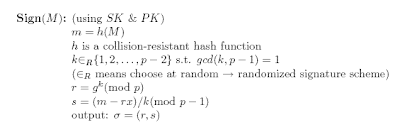
مرحبا بكم في رمضان
welcome Ramadan. months full forgiveness and mercy. Love that always meet the longing of the soul unto God. this month I will submit everything to you my love. Not because of heaven or hell, but because you love ....
the word 'embek' it's only bleat ... but in this blog is that embek not only bleat ... if more desperate because many here love Poetry. If you have a headache more IT problems here also any posts about it .. so,,, Embek indeed have a taste







Kriptoanalisis also be defined as art or science to solve ciphertext become plaintexts using the midst security a cryptography system. This makes Kriptoanalisis labeled as illegal ways to translate ciphertext. Based on the activities of attackers, the attack that occurred can be divided into two types, namely:
a) passive attacks, where attack is attacker only monitors the channel communication. Passive attacker only threaten confidentiality of data.
b) active attacks, where attack is
attacker trying to remove, add, or in a way that another change in the transmission path of communication. Active attacker will threaten data integrity and authentication, and confidentiality.
Types of Seizures
There are several types of attacks that can be done by kriptoanalis, with the assumption that kriptoanalis had cryptography algorithm used in the system that will be attacked, namely:
1. Ciphertext Only Attack
'Kriptoanalis' only have a few ciphertext a result of tapping. But he does not know the key and the plaintext. Employment 'kriptoanalis' is seeking to obtain the decryption key the plaintext.
2. Known Plaintext Attack
Kriptoanalis successfully obtain discount
the plaintext and a full the chipertext, but he believes that both are interconnected. For example, the snippet plaintext which is believed to be a letter, because there is the phrase "respect us." 'Kriptoanalis' then try to match the chipertext that have meaning "respect us." Next task is to find a little of the decryption key information that he had it.
3. Candy Plaintext Attack
"Kriptoanalis" not only know a plaintext and the chipertext as in the case 2 above, but also free to choose some plaintext considered in accordance with a certain part of ciphertext. "Kriptoanalis" next task is to a key of guess.
4. Adaptive Candy Plaintext Attack. This attack is a special case of third type of attack mentioned above. "Kriptoanalis" not can only select a the plaintext would be encrypted, but can also modify choice based on the results of previous encryption. In Candy the plaintext attack, it may only can select a block for large plainteks encrypted, while he is on the attack can block plaintext choose a smaller and then select the other based on the results previously.
5. Candy Ciphertext Attack
"Kriptoanalis" can choose which ciphertext different decryption and to have access against plaintext encrypted. As example, "kriptoanalis" have access to the box
electronic process that can perform decryption automatically. Employment is "kriptoanalis" find the decryption key.
6. Candy Text
Candy is a combination of plaintext attack Candy and ciphertext attack. Here "kriptoanalis" already know the encryption algorithm ciphertext used and that will be read. "Kriptoanalis" can also select the plaintext would be cipherteks encrypted with spouse raised with a particular secret key.
Conditions that ensure security algorithms
There are 3 conditions that, when fulfilled by the algorithm cryptography, it will be able to guarantee security confidential communication made, namely:
1. If the cost to attack or penetrate cryptography algorithms that are used more than the price information will be obtained from results of these attacks. For example, the required computer system is worth 1 billion to penetrate algorithm that is used to protect information is worth 500 million.
2. When the time needed to penetrate algorithm is longer than the validation who wish to obtain information. For example, the time to penetrate a credit card is 1 years, whereas before the 1 year credit card is no longer valid.
3. When cipherteks produced by a cryptography algorithm less than cipherteks required to penetrate algorithm it. For example, of 1000 bits is required cipherteks to hit the key that is used on an algorithm, while the data resulting from the size of the encryption process is less of 1000 bits.

Dr. Taher Elgamal
(born 18 August 1955) is an Egyptian cryptographer. Elgamal is sometimes written as El Gamal or ElGamal, but Elgamal is now preferred. In 1985, Elgamal published a paper titled A Public key Cryptosystem and A Signature Scheme based on discrete Logarithms in which he proposed the design of the ElGamal discrete log cryptosystem and of the ElGamal signature scheme. The latter scheme became the basis for Digital Signature Algorithm (DSA) adopted by National Institute of Standards and Technology (NIST) as the Digital Signature Standard (DSS). He also participated in the 'SET' credit card payment protocol, plus a number of Internet payment schemes.
Elgamal has gained a Bachelor of Science degree from Cairo University, and Masters and Doctorate degrees in Computer Science from Stanford University. He served as chief scientist at Netscape Communications from 1995 to 1998 where he was a driving force behind SSL. He also was the director of engineering at RSA SecuritySecurify in 1998 and becoming their CEO. When Securify was acquired by Kroll-O'Gara[1], a company providing Independent IT Controls measurement and software verification at the binary level. In October 2006 he joined Tumbleweed Communications [2] in a capacity of a Chief Technology Officer. Tumbleweed was acquired in 2008 by Axway Inc. He is an advisor to Onset Ventures, glenbrook partners, PGP corporation, Arcot Systems, Finjan, Facetime and serves as Chief Security Officer of Axway, Inc. Inc. before founding he became the president of its information security group. In 2008, Securify was acquired by Secure Computing and is now part of McAfee. In addition, Elgamal sits on the board of Vindicia, a company which provides online payment services as well as the Advisory Board of SignaCert, Inc.









